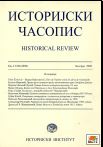Религијска пракса становника космајских рудника у доба Царства
Religious Practice of the Inhabitants of the Kosmaj Mines in the Period of the Empire
Author(s): Dragana KunčerSubject(s): History
Published by: Istorijski institut, Beograd
Keywords: Kosmaj; ancient mining; ancient cults; Upper Moesia; votive epigraphic monuments; nummi metallorum
Summary/Abstract: The preserved material remnants of religious practice at the time of the Roman Empire in Kosmaj generally originate from the second and third centuries A.D. – the period when the mine was most active. The presence of Roman, Greek and oriental cults has been recorded. It is believed that they testify to the diverse origin of the inhabitants of the Kosmaj mines who came, among other places, from Thrace, Bithynia, Phrygia and Dalmatia. With regard to Roman deities witnessed in epigraphic monuments in Kosmaj, they are interpreted in two ways: it is considered that they reflect the state cult or social obligation in some inscriptions, while in other inscriptions their mention is considered the expression of a personal religious need of the dedicators. As in many other mining areas, the existence of the mine and the connection of the Kosmaj population with the mine and activities within the mine resulted in the creation of cults of gods that were considered protectors of miners and mineral wealth.
Journal: Историјски часопис
- Issue Year: 2015
- Issue No: 64
- Page Range: 13-32
- Page Count: 20
- Language: Serbian

